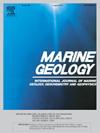阿拉伯海西南部表层碎屑沉积物的来源和搬运-沉积过程:来自粒度端元组分分析的见解
IF 2.2
3区 地球科学
Q2 GEOSCIENCES, MULTIDISCIPLINARY
引用次数: 0
摘要
阿拉伯海是研究表层碎屑沉积物来源和搬运-沉积过程的理想区域。值得注意的是,粒度端元组分(EMC)分离方法是这一探索的有力工具。通过将该方法与矿物学和形态学特征分析相结合,我们确定了适合研究区域的4种EMCs (EMC1-EMC4),并阐明了多种强迫在控制物源和运输-沉积过程中的作用。研究结果表明,研究区表层碎屑沉积物的来源变化和不同的输运机制决定了其粒度分布格局。EMC1超细端元以来自德干高原和西印度洋的玄武岩风化产物为主,受阿拉伯半岛内部和非洲东北部风沙的影响较小。EMC2、EMC3和EMC4分别代表主要来自阿拉伯半岛不同地区的细粒、粗粒和超粗粒风沙组分。季风环流将富含蒙脱石的超细沉积物向东穿过印度陆架,而环极深水(LCDW)则将它们向北长距离输送。此外,LCDW在索马里盆地北部逆时针流动,受到嘉士伯山脊的阻碍,导致其携带的超细沉积物沉积。各种风系统的相互作用使大小选择性输送成为可能:细EMCs通过对流层中层路径穿越,而粗EMCs则局限于对流层下层。西南季风有利于细粒状电磁干扰南移,阻碍粗粒状电磁干扰南移沉降。本文章由计算机程序翻译,如有差异,请以英文原文为准。
Sources and transport-sedimentation processes of surficial detrital sediments in the southwest Arabian Sea: Insights from grain-size end-member component analysis
The Arabian Sea is an ideal region for exploring the sources and transport-sedimentation processes of surficial detrital sediments. Notably, grain-size end-member component (EMC) separation methods are powerful tools for this exploration. Through integration of this method with mineralogical and morphological characterization analyses, we identified four EMCs (EMC1-EMC4) suitable for the study area and elucidated the role of multiple forcings in controlling sources and transport-sedimentation processes. The findings revealed that variations in sources and diverse transport mechanisms govern the grain-size distribution patterns of surficial detrital sediments in the study area. The EMC1 ultrafine end-member is dominated by basalt weathering products from the Deccan Plateau and the west Indian Ocean, and is slightly influenced by aeolian dust from the interior of the Arabian Peninsula and northeast Africa. EMC2, EMC3, and EMC4 represent fine, coarse, and ultra-coarse fractions of aeolian dust primarily from different regions of the Arabian Peninsula, respectively. Monsoon circulation transports smectite-rich ultrafine sediments eastward across the Indian shelf, while Lower Circumpolar Deep Water (LCDW) carries them northward over long distances. Furthermore, the LCDW flows anticlockwise in the north Somali Basin, hindered by the Carlsberg Ridge, leading to the deposition of the ultrafine sediments it carries. Various wind systems interactions enable size-selective transport: fine EMCs traverse via mid-tropospheric pathways, whereas coarse EMCs are confined to the lower troposphere. The southwest monsoon facilitating the transport of fine EMC southward while impeding the transport-sedimentation of coarse EMCs.
求助全文
通过发布文献求助,成功后即可免费获取论文全文。
去求助
来源期刊

Marine Geology
地学-地球科学综合
CiteScore
6.10
自引率
6.90%
发文量
175
审稿时长
21.9 weeks
期刊介绍:
Marine Geology is the premier international journal on marine geological processes in the broadest sense. We seek papers that are comprehensive, interdisciplinary and synthetic that will be lasting contributions to the field. Although most papers are based on regional studies, they must demonstrate new findings of international significance. We accept papers on subjects as diverse as seafloor hydrothermal systems, beach dynamics, early diagenesis, microbiological studies in sediments, palaeoclimate studies and geophysical studies of the seabed. We encourage papers that address emerging new fields, for example the influence of anthropogenic processes on coastal/marine geology and coastal/marine geoarchaeology. We insist that the papers are concerned with the marine realm and that they deal with geology: with rocks, sediments, and physical and chemical processes affecting them. Papers should address scientific hypotheses: highly descriptive data compilations or papers that deal only with marine management and risk assessment should be submitted to other journals. Papers on laboratory or modelling studies must demonstrate direct relevance to marine processes or deposits. The primary criteria for acceptance of papers is that the science is of high quality, novel, significant, and of broad international interest.
 求助内容:
求助内容: 应助结果提醒方式:
应助结果提醒方式:


